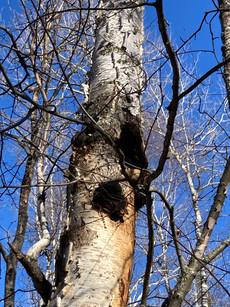Chaga Mushroom Hunting
- Ed Joice

- Jan 18, 2023
- 3 min read
One of the mushrooms that a lot of people seem to know about is chaga (inonotus obliquus). Online I see ads all the time about all of the antioxidant and cancer preventing properties of chaga. In Minnesota, it’s not uncommon to hear folks talking about their aunt who brews chaga tea. Even on forums for deer or grouse hunting, folks occasionally will post a picture of a large chaga harvest made while walking the woods in the fall. So why is chaga such a big deal?
To start with, it makes a delicious coffee or tea-like beverage that is delicious. Beyond that though, chaga actually does have inotodiol with cell growth inhibition properties. There is also evidence of beta-D-glucans found in chaga helping to lower blood sugar levels. Chaga has polysaccharides which can help reduce cholesterol. It also can help to lower blood pressure, promote healthy kidney and liver functions, and foster a healthier immune system. With all that, the fact that it’s a tasty beverage is just a bonus.
How to identify chaga?
Chaga consists of black scales or warts growing on a tree often in a round dome out of the side of the trunk. It can resemble a burl to an untrained eye. If the outer black scales are removed, the interior of the chaga is a lighter brown, marbled with golden structures. The interior of the chaga is relatively hard compared to many other fungi.
Another key attribute of chaga is that it grows predominantly on Birch trees, which means that if you find what you think is chaga on a tree that you know for sure is not a birch, there is a good chance it’s not chaga. Even if it is chaga, the only chaga that you want to consume is from birch trees. Chaga from maples, ash, hop hornbeam and other trees does not have the same medicinal properties as that obtained from birch trees.
How and when to harvest chaga?
Chaga can be harvested any time of the year but the best time to harvest is in the late fall to the early spring when temperatures are at or below freezing. I keep an eye out for it when hunting in late fall or cross country skiing in the winter. At this time the mushroom is dormant, whereas during the late spring, summer and fall the mushroom is growing. Harvesting during this dormant season is best for the mushroom that remains and the tree as well. Use a hatchet, hammer, chisel, or very carefully using a strong and stiff knife. Be very careful not to cut yourself or to cut too deeply into the tree, as you want to only extract the mushroom. It’s better to err on the side of caution and remove less than you think is there, rather than more.
How to use chaga in the kitchen?
The main use of chaga is as a tea or beverage. It could also be made into a seasoning or salt, or ground up and encapsulated if you are only seeking the health benefits. Before we get there though, you have to convert this brownish black chunk of fungi into something you can work with. Essentially, you’ll want to dry it and grind it into a powder. Then you can store it in a container in the freezer, a la coffee grounds.
















Comments